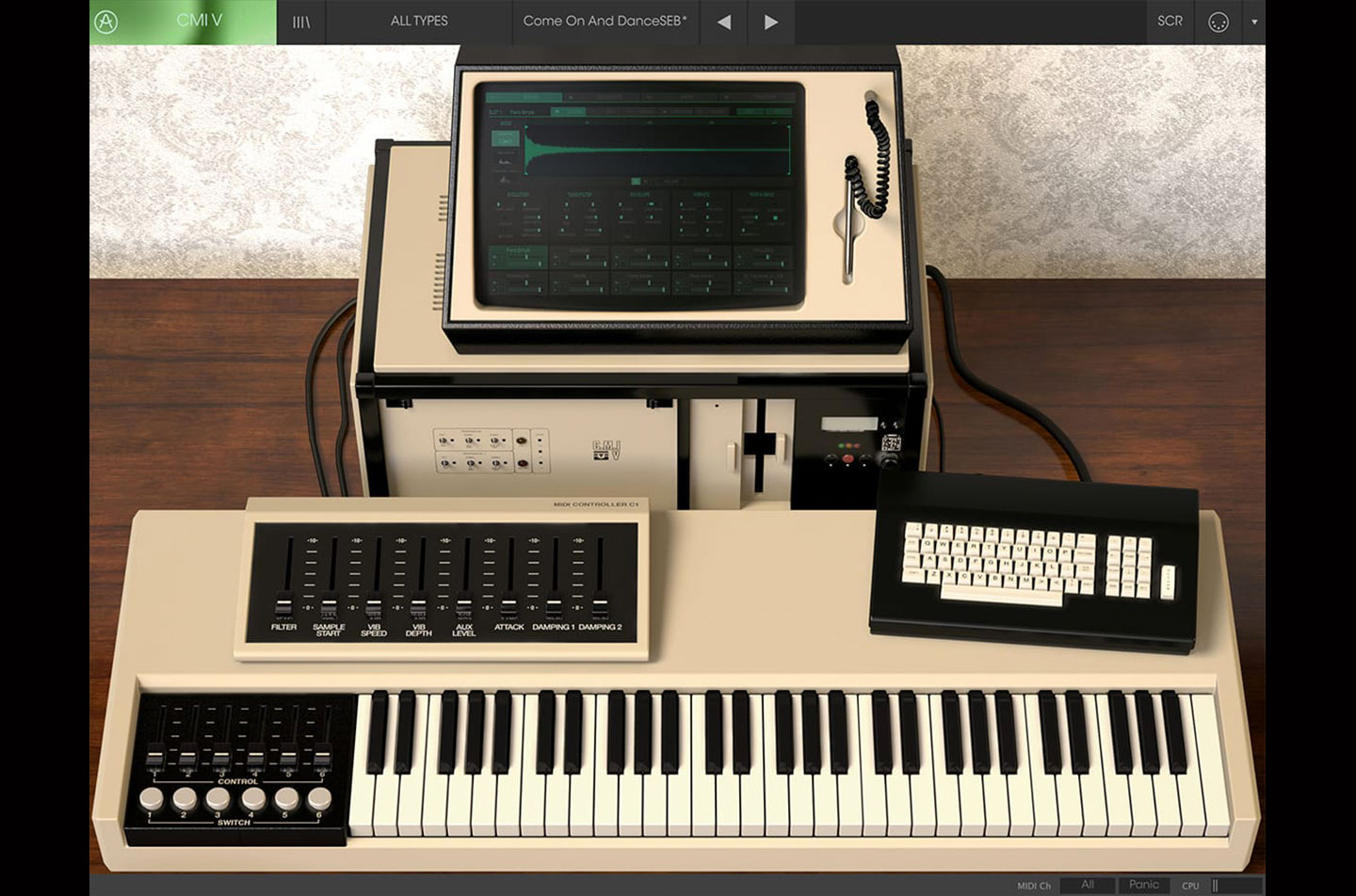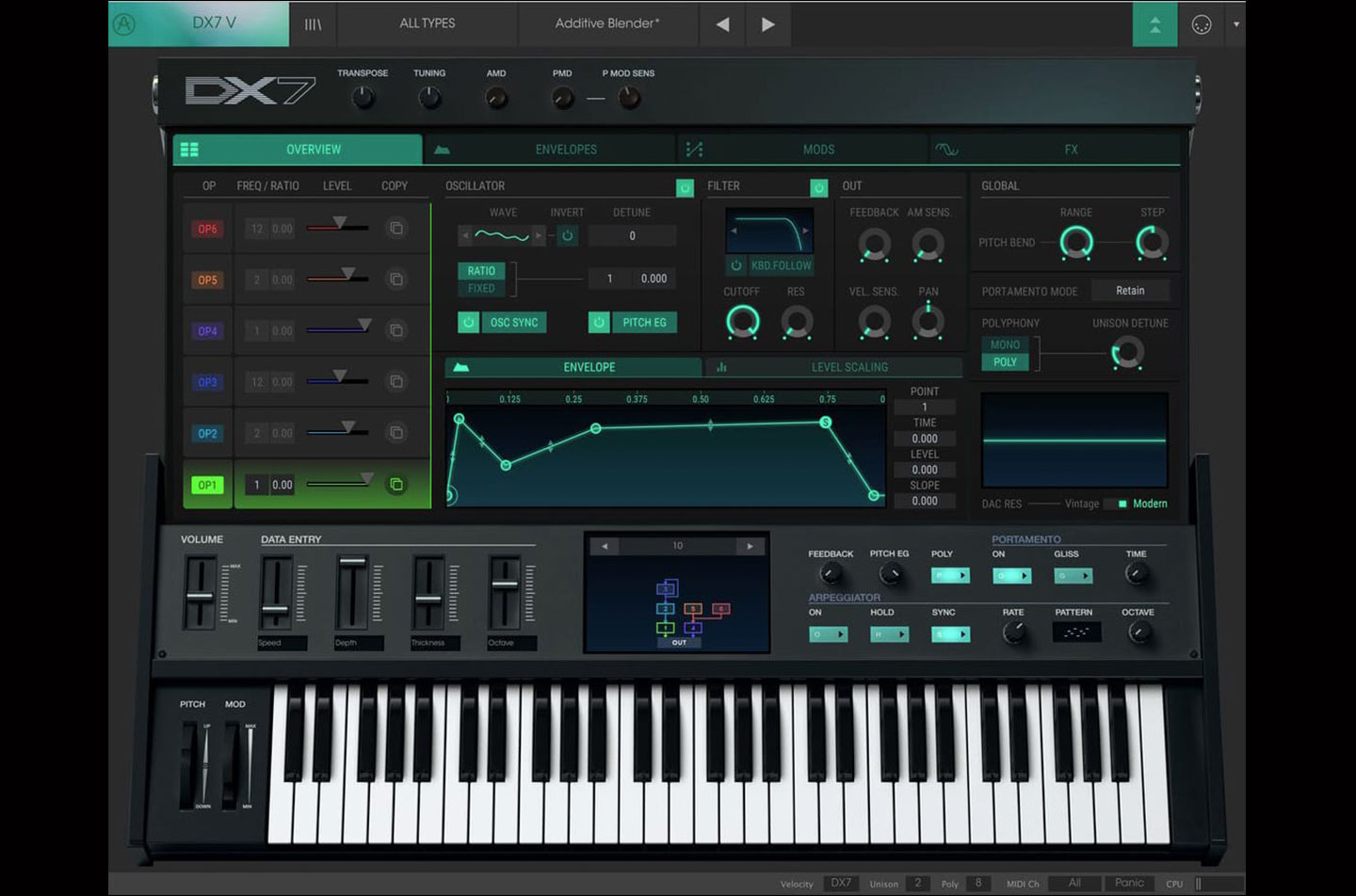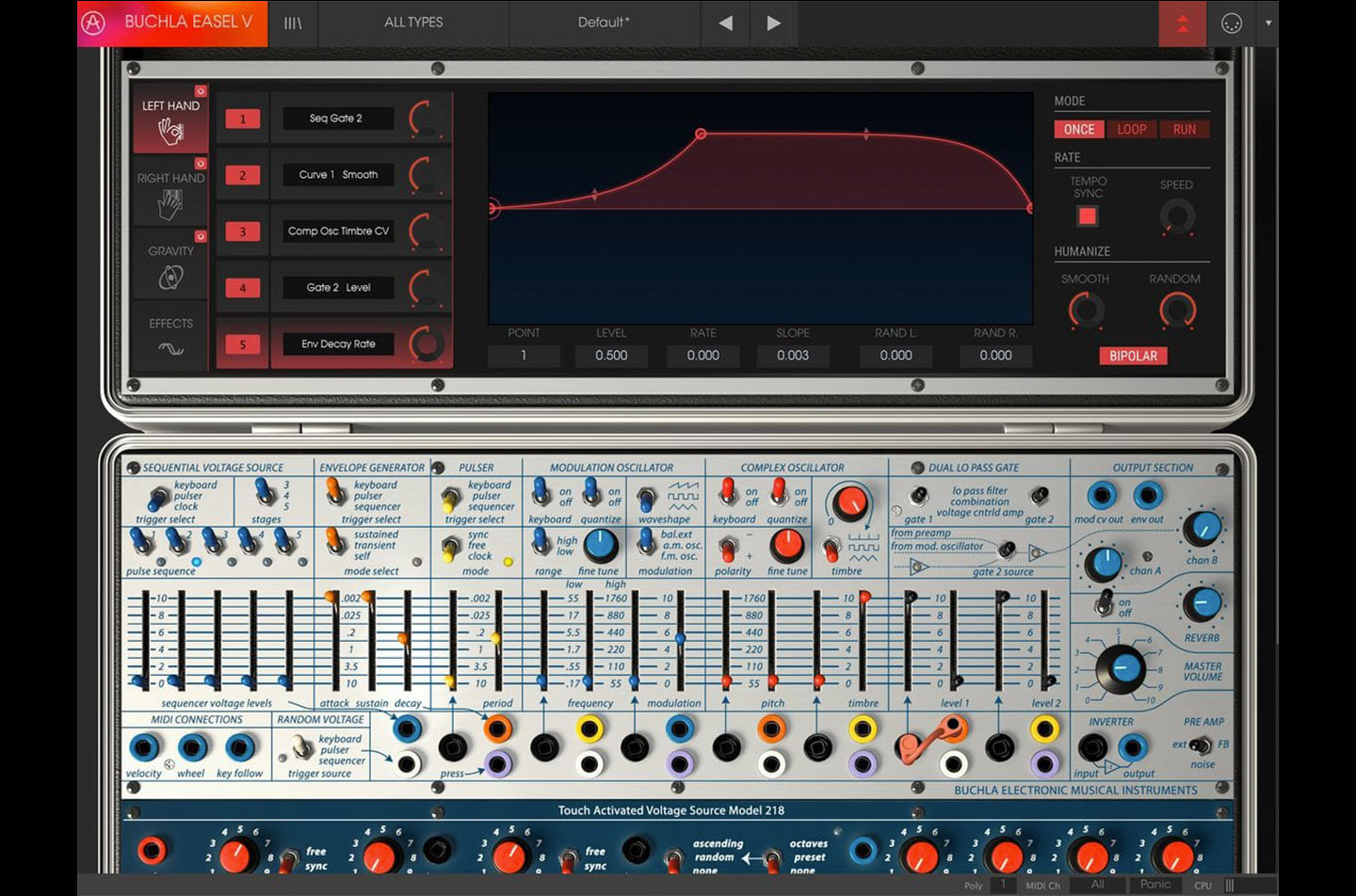- It's been two years since we reviewed Arturia's flagship virtual instrument suite V Collection 4. While other development houses tend to bounce between classic and modern designs, Arturia's vision has remained steadfast: recreating vintage hardware in software form, with heavy concentration on the details. Last year they released the fifth iteration of the collection, which shifted towards the non-electronic side of the musical spectrum with organs and pianos among the new inclusions. This time around, however, they've added some revered synthesisers that will have many electronic musicians excited.
First up is CMI V, which recreates the legendary Fairlight CMI, a groundbreaking digital sampler, synthesiser and audio workstation produced in 1979. The Fairlight found fame in part through Herbie Hancock's cameo on Sesame Street. It was a cutting-edge tool for its time and was eagerly adopted by the likes of Art Of Noise, Stevie Wonder and Peter Gabriel. Arturia incorporate many of the best parts of the original (including all of the original factory samples) but pull the Fairlight into the future, with modern 44.1 kHz / 16 bit sampling, full MIDI compatibility, sequencer control and an expanded number of instrument slots (ten). Additionally, there's a useful mixer with mute/solo/pan/volume controls, which also allows you to choose from a selection of 24 effects. While custom samples can be loaded into CMI V, part of the instrument's charm lies in using the original samples and seeing what you can do with them. With all the advances in UI and UX design over the past 30-odd years, modern samplers present a much more user-friendly experience. So the CMI V's value for many may be more nostalgic than utilitarian.
Another welcome addition is the DX7 V, a recreation of (you guessed it) the Yamaha DX7 FM synthesiser. Everyone should be familiar with the game-changing digital synth, whether from hearing it in basically every pop song from the '80s or having seen the modern remakes from Korg and Yamaha. During my tests, it became clear that Arturia invested a considerable amount of time in adding bells and whistles to the DX7 foundation. The DX7 V has six operators, each with independent feedback controls and a choice of 25 different waveforms, which include the DX classics, a selection of the TX81Z waveforms and others besides. Modulation must have been at the top of the list on Arturia's whiteboard as well. There's a deep mod matrix that lets you control nearly every parameter of the synth using MIDI sources, two LFOs, a sequencer, envelopes and macro controls. To attempt to infuse some of the original instrument's character into the DX7 V, Arturia added some subtle configurable parameters such as the 12-bit DAC/analogue companding circuitry from Yamaha's original hardware. They also kept to the somewhat clinical look and feel of the original (including its complexities), which makes for a higher learning curve than some would like. Thankfully, there's a large library of presets (hundreds more than the 64 of the original) for those who just want to play.
In the end, the star of V Collection 6 is undoubtedly the Buchla Easel V. It recreates the venerated Buchla Music Easel semi-modular suitcase synthesiser, which has developed somewhat of a cult following recently (everyone from Kaitlyn Aurelia Smith to Surgeon has fallen under its spell). After living in relative obscurity for decades, this is now the second virtual recreation of a Buchla released this year—the other being Softube's take on the 259e, which we reviewed last week. Arturia kept Don Buchla's genius design largely intact but added a generous complement of new features. Within the synth architecture itself, they added a noise source, chromatic quantisation to the oscillators, a setting that converts the EG to an LFO, four voice polyphony, and, of course, full MIDI control. This already puts Buchla Easel V miles ahead of the original in terms of usability. But Arturia took things even further with an advanced panel that houses a 32-step polyphonic sequencer, five complex voltage control functions and what they call the Gravity Universe: a CV playground that uses game physics to control parameters and generate notes. Finally, as with the other Arturia plug-ins, there is a panel housing ten effects. I was surprised to see that this same panel also lets you define the vactrol response characteristics of the Dual Low Pass Gate, a small detail that actually can have a noticeable effect on the sound of the synth. Overall, the Buchla Easel V shares the same strengths and weakness as Softube's offering. It excels in sound but at the expense of some fairly heavy CPU requirements. Arturia offers free demos of the V Collection suite, so it would be worth downloading a copy and seeing how your system fares here.
The three instruments above represent a part of what's been added to V Collection 6. There's also a new Clavinet instrument, major updates to Analog Lab and Piano and some assorted GUI updates for existing instruments. When you add these new options to the collection's existing synths like Modular V, Jup-8 V and ARP2600 V, the value for money (21 powerful instruments for $399) is outstanding. If you own Native Instruments' Komplete Kontrol or Maschine, it's made even better by Arturia's support for the NKS standard, which provides tight hardware integration and preset browsing. I actually prefer this workflow over Arturia's own Analog Lab, but if you're not an NI customer the Analog Lab is a good option, especially if you already own one of Arturia's supported MIDI controllers.
Ratings:
Cost: 4.2
Versatility: 4.2
Ease of use: 4.0
Sound: 4.5
 In the end, the star of V Collection 6 is undoubtedly the Buchla Easel V. It recreates the venerated Buchla Music Easel semi-modular suitcase synthesiser, which has developed somewhat of a cult following recently (everyone from Kaitlyn Aurelia Smith to Surgeon has fallen under its spell). After living in relative obscurity for decades, this is now the second virtual recreation of a Buchla released this year—the other being Softube's take on the 259e, which we reviewed last week. Arturia kept Don Buchla's genius design largely intact but added a generous complement of new features. Within the synth architecture itself, they added a noise source, chromatic quantisation to the oscillators, a setting that converts the EG to an LFO, four voice polyphony, and, of course, full MIDI control. This already puts Buchla Easel V miles ahead of the original in terms of usability. But Arturia took things even further with an advanced panel that houses a 32-step polyphonic sequencer, five complex voltage control functions and what they call the Gravity Universe: a CV playground that uses game physics to control parameters and generate notes. Finally, as with the other Arturia plug-ins, there is a panel housing ten effects. I was surprised to see that this same panel also lets you define the vactrol response characteristics of the Dual Low Pass Gate, a small detail that actually can have a noticeable effect on the sound of the synth. Overall, the Buchla Easel V shares the same strengths and weakness as Softube's offering. It excels in sound but at the expense of some fairly heavy CPU requirements. Arturia offers free demos of the V Collection suite, so it would be worth downloading a copy and seeing how your system fares here.
In the end, the star of V Collection 6 is undoubtedly the Buchla Easel V. It recreates the venerated Buchla Music Easel semi-modular suitcase synthesiser, which has developed somewhat of a cult following recently (everyone from Kaitlyn Aurelia Smith to Surgeon has fallen under its spell). After living in relative obscurity for decades, this is now the second virtual recreation of a Buchla released this year—the other being Softube's take on the 259e, which we reviewed last week. Arturia kept Don Buchla's genius design largely intact but added a generous complement of new features. Within the synth architecture itself, they added a noise source, chromatic quantisation to the oscillators, a setting that converts the EG to an LFO, four voice polyphony, and, of course, full MIDI control. This already puts Buchla Easel V miles ahead of the original in terms of usability. But Arturia took things even further with an advanced panel that houses a 32-step polyphonic sequencer, five complex voltage control functions and what they call the Gravity Universe: a CV playground that uses game physics to control parameters and generate notes. Finally, as with the other Arturia plug-ins, there is a panel housing ten effects. I was surprised to see that this same panel also lets you define the vactrol response characteristics of the Dual Low Pass Gate, a small detail that actually can have a noticeable effect on the sound of the synth. Overall, the Buchla Easel V shares the same strengths and weakness as Softube's offering. It excels in sound but at the expense of some fairly heavy CPU requirements. Arturia offers free demos of the V Collection suite, so it would be worth downloading a copy and seeing how your system fares here. The three instruments above represent a part of what's been added to V Collection 6. There's also a new Clavinet instrument, major updates to Analog Lab and Piano and some assorted GUI updates for existing instruments. When you add these new options to the collection's existing synths like Modular V, Jup-8 V and ARP2600 V, the value for money (21 powerful instruments for $399) is outstanding. If you own Native Instruments' Komplete Kontrol or Maschine, it's made even better by Arturia's support for the NKS standard, which provides tight hardware integration and preset browsing. I actually prefer this workflow over Arturia's own Analog Lab, but if you're not an NI customer the Analog Lab is a good option, especially if you already own one of Arturia's supported MIDI controllers. Ratings: Cost: 4.2 Versatility: 4.2 Ease of use: 4.0 Sound: 4.5
The three instruments above represent a part of what's been added to V Collection 6. There's also a new Clavinet instrument, major updates to Analog Lab and Piano and some assorted GUI updates for existing instruments. When you add these new options to the collection's existing synths like Modular V, Jup-8 V and ARP2600 V, the value for money (21 powerful instruments for $399) is outstanding. If you own Native Instruments' Komplete Kontrol or Maschine, it's made even better by Arturia's support for the NKS standard, which provides tight hardware integration and preset browsing. I actually prefer this workflow over Arturia's own Analog Lab, but if you're not an NI customer the Analog Lab is a good option, especially if you already own one of Arturia's supported MIDI controllers. Ratings: Cost: 4.2 Versatility: 4.2 Ease of use: 4.0 Sound: 4.5